ERA Country Report 2023
Estonia
Edited by Katrin Männik (EFIS)
as part of ‘Development of the ERA Scoreboard, the ERA Dashboard and the Regular Reports’ project for the European Commission, Directorate-General for Research and Innovation under Framework Contract N° 2018/RTD/A2/OP/PP-07001-2018 Lot 2 (EDAR)
Click here to download this country report![]()
- Table of contents
-
ERA Country Report 2023: Estonia
1. National context
1.1. Overview of the ERA policy agenda implementation
1.2. Policy context
2. Assessment of the Implementation of the ERA Policy Agenda and ERA Priorities
2.1. ERA Priority 1: Deepening a truly functional internal market for knowledge
2.2. ERA Priority 2: Taking up together the challenges posed by the twin green and digital transition and increasing society’s participation in the ERA
2.3. ERA Priority 3: Amplifying access to research and innovation excellence across the Union
2.4. ERA Priority 4: Advancing concerted research and innovation investments and reforms
3. Country-specific drivers and barriers
4. Final remarks
5. Bibliography
6. Annexes
6.1. Annex 1: Graphs
ERA Country Report 2023: Estonia
|
Key takeaways:
|
1. National context
1.1. Overview of the ERA policy agenda implementation
The country is a Moderate Innovator on the European Innovation Scoreboard (EIS) with an Innovation Index score of 98.6% relative to European Union (EU) average in 2023. Estonia is among the fastest growing (29.3%) EU innovation performers between 2016-2023. There have also been a number of setbacks in innovation performance during the recent multi-crises period. However, the level of green innovations is still below the EU average.^
Estonia is successful in EU framework programmes, holding the 3rd position in relation to GDP (273% over EU-27 in retained proposals to applications) in 2022.^ The country keeps the leadership position as the EU’s most entrepreneurial country for tech start-ups.^
The Research, Development, Innovation and Entrepreneurship (RDIE) Strategy was agreed for 2021-2035 and is a key R&I policy in Estonia.^ The general objective of the strategy is that Estonian research, development, innovation and entrepreneurship work together to increase the well-being of Estonian society and the productivity of the Estonian economy, by providing competitive and sustainable solutions for the development needs of Estonia and the world. This strategy will help Estonia to implement the ERA Priorities at the national level. Additionally, alignment with ERA has been evidenced by Estonia’s commitment to all ERA Actions.
1.2. Policy context
There are two main responsible ministries for R&I policy in Estonia: the Ministry of Education and Research (MoER) and the Ministry of Economic Affairs and Communications (MoEC). The cooperation between these two ministries has increased in recent years.^ Support for agencies includes the Estonian Research Council (‘Eesti Teadusagentuur - ETAg’) and the Entrepreneurship and Innovation Foundation (‘Ettevõtluse ja Innovatsiooni Sihtasutus - EAS and KredEx’), the latter of which was created in 2022 by merging two former enterprise support agencies to strengthen the support structure of research and innovation in Estonia. The Ministry of Climate (MoC) which focuses on climate policy has also played an increasing role in R&I related to the green transition.
The RDIE Strategy has a joint steering committee (‘TAIE juhtkomisjon’) consisting of representatives from both ministries as well as key stakeholders. The highest advisory body for the strategy is the Research and Development Council (‘Teadus- ja Arendusnõukogu’). The strategy is approved by the Council and the Parliament (‘Riigikogu’). The most significant priorities of the RDIE strategy are to: 1) address society’s development needs; 2) increase efficiency and impact of science and researchers; and 3) make business more RDI-intensive. There are five key development fields agreed in the RDIE strategy including four smart specialisation areas: 1) digital solutions across all areas of life; 2) health technologies and services; 3) valorisation of local resources; 4) smart and sustainable energy resources; and 5) viable Estonian society, language and cultural space. Another key R&I policy frame, the Organisation of Research and Development Act (‘Teadus- ja arendustegevuse korralduse seadus’),^ is currently under amendment.
2. Assessment of the Implementation of the ERA Policy Agenda and ERA Priorities
This chapter has two objectives: 1) It qualitatively assesses the state-of-play of the implementation of the ERA actions that Estonia has committed to. The qualitative information stems from the OECD STIP survey 2023, the European Innovation Scoreboard, the Estonian European Semester Reports, and additional desk research; 2) It quantitatively assesses the country’s progress towards achieving the ERA priorities as set out on the Pact for Research and Innovation in Europe. The presented quantitative information is mainly based on the ERA Scoreboard and ERA Dashboard indicators and covers longer-term trends since 2010. Additionally, general indicators for the overall R&I system are outlined in Table 1. More detailed information on the data and graphs can be found in Annex 1. This report will serve as a baseline for reporting in the future.
| Indicator |
Most recent EU average |
Most Recent Metric |
| Gross Domestic Expenditure on R&D (GERD) as a percentage of GDP |
2.26 (2021) |
1.75 (2021) |
| Government Budget Allocations for R&D (GBARD) as a share of GDP |
0.76 (2021) |
0.69 (2021) |
| Researchers (in full-time equivalent) per million inhabitants |
4,483.4 (2021) |
4,037.4 (2021) |
| Business Enterprise expenditure on R&D (BERD) as a percentage of GDP |
1.49 (2021) |
1.0 (2021) |
Source: compiled by research team based on the ERA Scoreboard and ERA Dashboard indicators
2.1. ERA Priority 1: Deepening a truly functional internal market for knowledge
2.1.1. State of play in the implementation of the ERA Actions
In relation to ERA Action 1: Enable Open Science, including through the European Science Cloud (EOSC),the Estonian Research Information System (‘Eesti Teadusinfosüsteem’) is coordinated by the Estonian Research Council and is a major source of open research data in Estonia. Any publicly supported research result (including projects, publications, patents, collections, scientific equipment, research infrastructures, products and services) must be deposited into the system. ADAPTER, which is driven by public universities and supported by the government, offers online access to Estonian R&I services for companies. In 2015, the Research Council established the Open Science Expert Group (‘Avatud teaduse ekspertkomisjon’) and the Estonian Research Council Principles and Recommendations for Developing National Policy^ was compiled.
The Estonian Research Infrastructure Roadmap 2019 (‘Eesti Teadustaristu teekaart 2019)^ ensures national support towards ERA Action 2: Propose an EU copyright and data legislative framework for research. Additionally, the Natural History Archives and Information Network (NATARC)^is presented by the EOSC Observatory as a good practice. NATARC is part of the European research infrastructure “Distributed System of Scientific Collections” (DiSSCo). ^ Estonia reported in the EOSC Survey 2021 that it has an action plan, concrete objectives, indicators to monitor process, associated financial planning and financial contributions already in place, as well as additional policies in planning. Work on the next Estonian Research Infrastructure Roadmap 2024 has started.
Considering ERA Action 3: Reform the Assessment System for research, researchers and institutions, the Organisation of Research and Development Act and Higher Education Act (‘Kõrgharidusseadus’)^ provides the framework for research assessment. Assessments of R&I have been organised by the Estonian Research Council either as regular or targeted evaluations since 2010. Regular evaluations assess the respective R&I fields against international benchmarks. Targeted evaluations are organised to prepare R&D strategic development plans or other scientific policy decisions and measures.
Responding to ERA Action 4: Promote attractive research careers, talent circulation and mobility, the Organisation of Research and Development Act and the Higher Education Actregulate R&D personnel, doctorate studies and the academic career path of Estonia. Doctoral studies have recently undergone significant changes. For example, from the 2022/2023 academic year, most doctoral student placements are offered as state-funded junior research fellow positions.^ The Education research and development programme 2023-2027 complements science-based career development of teachers and support specialists.^ The main research funding programmes provided by the Estonian Research Council fund a range of project types for both institutions and individuals, such as researcher grants, centres of excellence, proof-of-concept grants, inter-sectoral mobility support, and smart specialisation scholarships and programmes. A new Sectoral Mobility Measure (SekMo) supports the mobility of PhD and master’s degree holders, PhD students, and highly skilled personnel between academic and non-academic sectors for the purpose of conducting R&D activities.^ Startup Estonia aims to strengthen the Estonian start-up ecosystem and capacity of stakeholders.
In relation to ERA Action 5: Promote gender equality and foster inclusiveness the Gender Equality Plan of the Estonian Research Council for 2020-2027^ aims to ensure equal opportunities for researchers and to guarantee a supportive work environment for the employees of the Council. The Estonian Research Council is responsible for selecting outstanding Estonian women academics through the portal of AcademiaNet.
In relation to ERA Action 6: Protect academic freedom in Europe, the RDIE Strategy 2021-2035 presents research activities based on a person’s creative freedom, aimed at gaining, through scientific research, new knowledge about man, nature and society and their interactions. The Strategic Framework for Estonia’s participation in the research, development and innovation partnerships of the European Union^ determines the principles of state participation in partnerships. The decisions to finance participation in EU partnerships are based on the Programme of Participation in EU Partnerships.^
ERA Action 7: Upgrade EU guidance for a better knowledge valorisation is clearly addressed in Estonia. The thematic research and development support scheme called as TemTA programme addresses four smart specialisation areas defined as focus areas outlined within the RDIE Strategy Area Roadmaps.^ As part of the knowledge transfer doctoral program, the PhD students conduct research on a topic important to the partner institution or company and the university.^ It is a part of the SekMo programme, which is applicable also for the full ERA action 7.^ A proof-of-concept (PoC) grant is a competency-based research funding for experimental development. The recent call gave a priority to green policy.^ The Programme of applied research supports the development of innovative products, processes, technologies and services in businesses (the 5th call in September 2023). In 2023, the Applied Research Division of Metrosert^ (the biggest provider of metrological services in Estonia) was established, which is to support technology infrastructure and knowledge intensive businesses. Additionally, Brain Hunt^ is the best-known start-up accelerator in Estonia, where many innovative ideas have gone into practice.
The Estonian Research Infrastructure Roadmap 2019 under ERA Action 8: Strengthen research infrastructure contains a list of new nationally important research infrastructure units, or of those in need of modernisation. Based on the Open Science Expert Commissions’ recommendations, two open science analyses were implemented within the RITA programme, which also concern more specific data on the cost of long-term preservation of data, IP and copyright issues.^ The aim of digital repositories as e-infrastructures is to build IT capacity to support open access to data. The National Library of Estonia’s digital archive DIGAR stores online publications, print files and digitalised copies of publications pursuant to the Copyright Act.^ The Estonian Scientific Computing Infrastructure^ provides infrastructure and support services to research and business communities.
In relation to ERA Action 9: Promote international cooperation, Research in Estonia provides information and news about Estonian research and cooperation opportunities. The Research International Marketing Strategy 2023-2027^ aims to position Estonia as a strong science-based country.
2.1.2. Progress towards achieving ERA Priorities
Regarding progress towards Sub-priority 1.1: Open Science, the indicator on the share of publications available in open access was 39% in Estonia against 34% for the EU average in 2009 (Figure 5 in Annex 1). The progress until 2019 for Estonia has been slightly bigger with the indicator reaching 40.4% compared to 39.2% at the EU level.
Progressing towards Sub-priority 1.2: Research Infrastructures, the indicator on the number of European infrastructures (RI) in which Estonia participated in 2021 has remained modest. The country is contributing financially only to 5 RIs, whereas the EU average is 15.56 RIs (Figure 6 in Annex 1).
Under the Sub-priority 1.3: Gender equality, equal opportunities for all and inclusiveness, there are several indicators to present. The indicator proportion (%) of women among doctoral graduates by narrow fields of Science, Technology, Engineering and Mathematics (STEM) was 50% in Estonia, higher than the EU-27 (37.85%) in 2013. No significant progress is taken place until 2020 (Figure 7 in Annex 1).
The indicator proportion of papers with mixed gender authorship has remained lower for Estonia during the last decade, 47.9% in 2010 and 53.6% in 2020 (Figure 8 in Annex 1). The EU average has shown faster growth up to 62.7% in 2020. But the indicator proportion of women in authorships of the top 10% most cited publications has been higher in Estonia with a value of 36.7% against the EU-27 average of 28% (Figure 9 in Annex 1). However, in 2018 the share has lowered for Estonia, compared to a slight increase for the EU average. The indicator Women in Digital Index is above the EU result for Estonia with 63.2% in 2022 (Figure 10 in Annex 1).
Under the Sub-priority 1.4: Researchers’ careers and mobility and research assessment and reward systems, the indicator on the share of foreign doctorate students as a percentage of all doctorate students has overperformed the EU average during 2015-2020. If in 2015 there were 10.4% of doctorate foreigners in Estonia, the indicator achieved 25.6% in 2020 compared to 23.3% at average in EU (Figure 11 in Annex 1). The indicator new doctorate graduates per 1,000 inhabitants aged 25-34 has remained at the same level for Estonia with a value of 0.6 in 2020 like in the EU (Figure 12 in Annex 1). The indicator job-to-job mobility of Human Resources in Science and Technology has increased from 5.3 to 9.5 in Estonia during 2010-2020, surpassing the EU average of 6.8 (Figure 13 in Annex 1).
Under the Sub-priority 1.5: Knowledge valorisation, three quantitative indicators show visible progress in Estonia. The indicator share of public-private co-publications started from the same level in Estonia compared to the EU average in 2011. It achieved a much higher result in 2021, increasing over three times to 261.64 per million population against 133.89 for EU (Figure 14). The indicator business enterprise researchers as % of national total has increased in Estonia during the decade from 31.44% (2010) to 41.34% (2020). However, the level still remains far from the EU average of 55.28% in 2020 (Figure 16 in Annex 1).
The same situation is shown in the indicator business enterprise researchers in full-time equivalent per thousand employment in industry, which has shown a moderate improvement up to 4.40 in Estonia against the EU average of 6.89 in 2020 (Figure 17 in Annex 1). The situation regarding the intellectual property protection has diminished, as the indicator number of PCT patent applications divided by GDP in million Euros decreased in Estonia from 0.0034 to 0.0012 while at the same time the EU has maintained the same size around 0.002 (Figure 15 in Annex 1). The indicator share of innovating firms collaborating with higher education institutions or public/private research institutions has progressed from 8.2 to 15.0 in Estonia in 2010-2020 which is now over the EU average (Figure 18 in Annex 1). Estonia has launched several interventions to encourage collaboration between public and private sector including SekMo programme, Programme for Applied Research and Startup Estonia.
Under the Sub-priority 1.6: Scientific leadership, the indicator number of scientific publications among the top-10% most cited publications worldwide as a percentage of all publications remains below the EU average but it has slightly increased up to 8.8% in 2020 against to 9.8% in EU (Figure 19 in Annex 1). Academic Freedom Index in Estonia has been stable at 0.97 level (2010-2022), which is above the EU average (Figure 20 in Annex 1).
Regarding the progress towards Sub-priority 1.7: Global engagement, the indicator international co-publications with non-EU partners per 1,000 researchers in the public sectoris extremely high in Estonia reaching to 1929 in 2021 which is three times higher than in 2010 and almost two times higher than the EU average (Figure 21). In contrast, the indicator European and international co-patenting in EPO applications at national and EU levelreflects significant gaps in science and applications. The indicator was 25 in Estonia in 2010 compared to 1461 on EU level (Figure 22 in Annex 1).
2.2. ERA Priority 2: Taking up together the challenges posed by the twin green and digital transition and increasing society’s participation in the ERA
2.2.1. State of play in the implementation of the ERA Actions
In response to ERA Action 10: Make EU research and innovation missions and partnerships key contributors to the ERA, the RDIE Strategy 2021-2035 encourages opportunities for international research cooperation. The strategy creates incentives for research institutions to take the lead in international networks, programmes and partnerships. It also supports participation of businesses in international and EU-wide partnerships and networks (e.g. CERN, ESA).
Considering ERA Action 11: An ERA for green energy transformation, the RDIE strategy sets the following objectives: 1) Estonia produces energy in a climate-neutral manner; 2) energy use in Estonia is improved and made more resource efficient; 3) a contribution is made to ensuring energy security. The Climate Change Adaption Development Plan until 2030^ considers energy and security of supply as one of the main priority areas and supports growing collaboration with Estonian researchers.
In relation to ERA Action 12: Accelerate the green/digital transition of Europe’s key industrial ecosystems, the TemTA program’s priority is given to all smart specialisation fields of Estonia including digital solutions across all areas of life, valorisation of local resources and smart energy systems of the RDIE strategy. The government has agreed the Green Transition Action Plan for three years. MoEC, MoER, MoC, and also Ministry of Regional Affairs and Agriculture (MoRAA) are the key policymaking bodies on digital and green transitions in relation to R&I in Estonia. The process of developing the Climate Law was announced on 20 September 2023.
The EAS and KredEx and the Environmental Investment Agency have launched specific measures for the green transition. In addition, the Green Fund (‘Rohefond`) was introduced by SmartCap. The fund supports early-stage greentech companies with high growth potential in strategic areas that are established and operating in Estonia. Foresight Centre published a report on scenarios of green transition of Estonia.^ Moreover, Deep Tech Action Plan 2023+ (‘Teadus- ja tehnoloogiamahuka iduettevõtluse ökosüsteemi arendamise tegevuskava’) was published by Startup Estonia.
Under ERA Action 13: Empower Higher Education Institutions, the Education Development Plan 2021-2035 follows the UN development goals: to ensure inclusive and high-level education and lifelong learning opportunities available to everyone, reduce inequality and be based on environmental sustainability and energy efficiency. In addition, the Education research and development programme 2023-2027 aims to support R&I targeted towards new generation of Estonian teachers and support specialists. The RDIE Strategy 2021-2035 sets higher education institutions in a central position for offering R&D human resources for more intensive R&D in Estonia. The programme RITA has involved higher education institutions for analysis and expertise that supports policymaking toward the ERA.
Under ERA Action 14: Bring Science closer to citizens, several contests are organised by the Estonian Research Council, such as the Open Call for Science Communication Projects, the National Contest of Young Inventors, the National Contest of Young Scientists, the Estonian National Contest of Educational Research, the National Contest for University Students or the Estonian Science Communication Award. In addition, the Student Researchers Festival takes place every spring, and the biggest entertaining science centre in the Baltics AHHAA Centre locates in Tartu, the Energy Discovery Centre.
2.2.2. Progress towards achieving ERA Priorities
With regard to progress towards Sub-priority 2.1: Challenge-based ERA actions, one of the available indicators is the Government Budget Allocations for R&D (GBARD) by NABS in energy; environment; transport, and telecommunications and other infrastructure. It reports a low funding for energy (only EUR 0.79 million in Estonia compared to EUR 188.04 million in EU) and transport, telecom and other infrastructure (only EUR 1.09 million in Estonia compared to EUR 133.25 million in the EU) in 2021. Both areas have even shown regressions since 2010 (Figure 23 in Annex 1). GBARD for environment has also decreased in Estonia during 2010-2021 from EUR 10.7 million to EUR 1.96 million, noticeably below the EU average. The indicator R&I investments (transnational cooperation): GBARD (EUR) allocated to Europewide transnational, bilateral or multilateral, public R&D programmes per FTE researcher in the public sector has increased to 1,752 in 2020 against 1,790 on EU level. Significant increase took place in 2020 (Figure 24 in Annex 1).
The indicator environmentally related government R&D budget as percentage of total government R&D has fluctuated significantly during the years, but it is generally in decline (Figure 25 in Annex 1). Only 1.32% of total government R&D is allocated to environmentally related R&D in Estonia in 2020 but it was 7.66% in 2011. The indicator national public and private investments as suggested in the SET Plan progress report 2021 has experienced a decreasing slope for Estonia from 2010 to 2020, while the EU values have increased (Figure 26 in Annex 1). The indicator OECD patents on environment technologies was surprisingly high for Estonia compared to EU-27 in 2010 with a value of 25.2, which decreased to 3.3 in 2019 (Figure 27 in Annex 1). The EU average has also decreased but fixed at 12.9 in 2018.
With regard to progress towards Sub-priority 2.2: Synergies with education and the European Skills Agenda, the indicator share of researchers receiving transferable skills training reports much achievement for Estonia. That is 60% in 2019 compared to 46% for EU-27 (Figure 28 in Annex 1).
In relation to Sub-priority 2.3: Synergies with sectoral policies and industrial policy, in order to boost innovation ecosystem, the indicator direct government support and indirect government support through R&D tax incentives as a percentage of GDP shows that Estonia performs below the EU average (Figure 29 in Annex 1). The indicator resulted in a share of 0.0551% in 2020 (EU 0,19%), which is even lower than a decade earlier. The tax incentives are still present in discussions.
Progress towards Sub-priority 2.4: An active citizen and societal engagement in R&I in all its dimensions is measured through the indicator trust in science, in which Estonia presents a share of 51,7%, higher than the EU average in 2021 (Figure 30 in Annex 1). The indicator research on social innovation (publications on ‘social innovation’ or ‘social entrepreneurship’) per million population has achieved better a result than the EU average in 2011 (3.008), also 2014-2017, but afterwards figures decreased. At the same time the EU average has grown steadily during the decade (Figure 31 in Annex 1).
2.3. ERA Priority 3: Amplifying access to research and innovation excellence across the Union
2.3.1. State of play in the implementation of the ERA Actions
In relation to Action 16: Improve EU-wide access to excellence, the Programme RITA (completed in 2023) aimed at funding socio-economic applied research based on the needs of the state (including support for strategic R&D activities, for knowledge-based policy formulation and for developing ETIS). In 2023, the measure on public innovation capacity building was initiated by the State Chancellery.^ Additionally, the Estonian Infrastructure Roadmap 2019 is a multi-ranking list of research infrastructures that has great impact in Estonia. The Estonian Scientific Computing Infrastructure provides computing and storage resources for the Estonian scientific community. The RDIE Strategy 2021-2035 sets the Estonian research to be high level, effective and diverse. Furthermore, the Estonian Agriculture and Fisheries Strategy 2030 (AFS 2030) expands the support for research, innovation and knowledge transfer of agriculture and fisheries.^
Under Action 17: Enhance public research institutions’ strategic capacity, the Mobilitas Pluss Programme offered an extensive package of support measures including: post-doctoral researchers coming from abroad to Estonia, returning researchers to Estonia, top-level researchers of international rank coming to Estonia, also training events and study visits for researchers, support for applying for an ERC grant, and Horizon 2020 ERA Chair, ERA Net and EIT support.
Estonia’s Liaison Office in Brussels and “Research in Estonia” portal have been separate activity lines for the programme. Another programme, Dora Pluss, aims to increase the attractiveness of Estonia for studies and research, and the international competitiveness of Estonian higher education. Both programmes’ financing periods are linked to the European Regional Development Fund. The Institutional Development Programme for R&D and higher education institutions called ASTRA has improved the universities’ study and research conditions, effectiveness and quality.
2.3.2. Progress towards achieving ERA Priorities
In terms of progress towards Sub-priority 3.1: More investments and reforms in countries and regions with lower R&I performance, the indicator increase (in percentage points) of total R&D expenditure expressed as a percentage of GDP has fluctuated for Estonia after 2011. The highest result was 0.73 in 2011, the lowest negative -0.4 in 2013 reaching to 0.01 in 2021. The EU average has performed slightly above zero but has decreased to -0.04 in 2021 (Figure 32 in Annex 1).
2.4. ERA Priority 4: Advancing concerted research and innovation investments and reforms
2.4.1. State of play in the implementation of the ERA Actions
Towards the overall goal of ERA Priority 4 in relation to funding, in 2019, Estonia made a political commitment to elevate public R&D funding to 1% of GDP. As part of the agreement, the annual increase in R&I funding is allocated as follows: 40% to the research system, 40% to business R&D support schemes, and 20% to different ministries. Estonia has achieved some balance in 2019 between national grant funding and basic institutional funding for research organisations. There is still a low proportion of institutional funding largely due to competitive-based programmes financed by EU structural funds.^
In relation to Action 19: Establish an ERA monitoring system, a reporting, monitoring and evaluation system has been agreed for the RDIE Strategy 2021-2035. The MoER and the MoEC jointly prepare an annual performance report on the implementation of the Strategy programmes. The performance report is presented to the RDIE Steering Committee and Research and Development Council. At least two interim evaluations are planned to assess the achievement of the objectives of the Strategy. The planning and implementation of national R&D activities are coordinated through the RDI Coordination Council (‘Koordinatsioonikogu’). The programme RITA and the Foresight Centre^ support policymakers with targeted analyses.
2.4.2. Progress towards achieving ERA Priorities
Regarding Sub-priority 4.1: Coordination of R&I investment, the indicator share of public R&D expenditure financed by the private sector has moderately increased from 3.77% (2010) to 6.55% (2020) in Estonia. During the same period, the EU average has remained around 8% (Figure 33 in Annex 1).
3. Country-specific drivers and barriers
The analysis conducted has identified factors that drive or hinder change in the national R&I context. A key driving factor is the collaboration between MoER and MoEC, the two key ministries supporting R&I in Estonia, which has improved in recent years. The involvement of additional ministries also supports progress on ERA Actions. Within the RITA programme scientific advisors were hired at nine ministries and the Government Office aiming to improve the ministries’ capabilities in R&I questions.^ Estonia has committed to all ERA Actions which has guided progress towards the relevant goals. For example, research funding and outcomes are publicly available, which supports the goals of ERA initiatives in open science. Another example is the recent reform of higher education to increase the attractiveness of doctoral studies and ensure academia can respond to societal needs.
One of the hindering factors of the Estonian R&I ecosystem refers to the limited R&I investments from the business sector. Although innovation in business has been scored highly, this mainly refers to process innovation rather than R&D innovation. There have been several public measures led by EAS and KredEx, and the Estonian Research Council to encourage businesses to increase collaboration with the R&D sector. Additionally, the recent institutional reforms in the R&I support system and the launch of a separate knowledge transfer office at Metrosert are expected to strengthen the R&I ecosystem.
As the majority of research funding is competitive, R&D organisations have faced difficulties in maintaining financial stability and this creates uncertainties for R&I actors. Overall, Estonia is quite vulnerable to external crises, and recent challenges have had large impacts on the Estonian economy. Nevertheless, the government has recently made a political commitment of a public R&D investment of 1% of GDP, which would significantly help in this regard.
4. Final remarks
Estonia has committed to all the ERA Actions of the ERA Policy Agenda. As evidenced throughout the report, Estonia has included the ERA Priorities within the national strategies and initiatives.
Estonia is known for its advanced e-governance (recently created a centre of excellence for data governance and open data)^ and a good level of basic ICT skills across different demographics. For example, the share of women in digital index was higher than the EU average in 2022. Additionally, Estonia is well-known for a rapidly growing start-up sector and high level of innovation amongst businesses, and there are improving linkages between the research and business sectors. In addition to digitalisation, Estonia has also placed a priority on climate policy and progressing towards EU climate goals. For example, SmartCap created the Green Fund and the Foresight Centre created green transition scenarios for Estonia that defined investment areas for key technologies. Nevertheless, Estonia positions far below the EU-27 average on environmental sustainability based on the European Innovation Scoreboard. Also, environmentally related government R&D budget allocations as percentage of total government R&D is in decline.
One of the key obstacles for Estonia to reach the EU objectives for the ERA is the level of funding for R&I overall. R&D expenditures as a share of GDP is lower than the EU average, and far from achieving the EU goal of 3%. In order to address this challenge, the “Estonia 2035” development strategy targets 2% of business R&D expenditures. There is also room for improvement on knowledge valorisation, the implementation of smart specialisation to increase the industrial productivity and supporting skilled labour and the next generation of researchers.
5. Bibliography
ADAPTER website, available at https://adapter.ee/en/
Education and Youth Board (Haridus- ja Noorteamet) website, available at https://harno.ee/en
Energy Discovery Centre (Energia avastuskeskus) website, available at https://www.energiakeskus.ee/en/
Entrepreneurship and Innovation Foundation (Ettevõtluse ja Innovatsiooni Sihtasutus - EAS and KredEx) website, available at https://eas.ee/en/
Environmental Investment Centre (Keskkonnainvesteeringute Keskus) website, available at https://kik.ee/en
`“Estonia 2035” development strategy (Strateegia “Eesti 2035”)’ website, available at https://valitsus.ee/en/estonia-2035-development-strategy/strategy/strategic-goals
Estonian Research Council (Eesti Teadusagentuur) website, available at https://etag.ee/en/
Estonian Research Council (2023). Eesti teaduse rahvusvahelise tutvustamise strateegia 2023-2027 (The Research International Marketing Strategy 2023-2027), available at https://etag.ee/wp-content/uploads/2022/12/Eesti-teaduse-rahvusvahelise-tutvustamise-strateegia-2023-2027.pdf
‘Estonian Research, Development, Innovation and Entrepreneurship Strategy 2021-2035 (Eesti teadus- ja arendustegevuse, innovatsiooni ning ettevõtluse arengukava 2021-2035)’, the Ministry of Education and Research website, available at https://vana.hm.ee/sites/default/files/taie_arengukava_kinnitatud_15.07.2021_211109a_en_final.pdf
Estonian Research Information System (Eesti Teadusinfosüsteem) website, available at https://www.etis.ee
‘Estonian Research Infrastructure Roadmap 2019 (Eesti teadustaristu teekaart 2019)’. Ministry of Education and Research, Estonian Research Council. The Estonian Research Council website, available at https://etag.ee/wp-content/uploads/2019/06/ETAg_Research_Infrastructure_Roadmap_2019.pdf)
Estonian Scientific Computing Infrastructure (ETAIS) website, available at https://etais.ee
Estonian Quality Agency for Education (Eesti Hariduse Kvaliteediagentuur) website, available at https://haka.ee/en/
European Commission, Directorate-General for Research and Innovation (2023), European Innovation Scoreboard 2023, available at: https://research-and-innovation.ec.europa.eu/statistics/performance-indicators/european-innovation-scoreboard_en
European Commission, Directorate-General for Research and Innovation, Hollanders, H.(2023), European Innovation Scoreboard 2023 Country profile Estonia, available at: https://ec.europa.eu/assets/rtd/eis/2023/ec_rtd_eis-country-profile-ee.pdf
European Commission (2023), 2023 Country Report – Estonia. Commission staff working Document, available at https://economy-finance.ec.europa.eu/system/files/2023-05/ET_SWD_2023_606_en.pdf, p. 46.
Foresight Centre (Arenguseire keskus) website, available at https://arenguseire.ee/en/
Gender Equality Plan of the Estonian Research Council (2021), the Estonian Research Council website, available at https://www.etag.ee/wp-content/uploads/2022/01/Estonian-Research-Council-Gender-Equality-Plan-2021.pdf
Law 8/2023 of 1 August, amending Law 03/2019, of 19 March, on Higher Education Act (Kõrgharidusseadus), Riigi Teataja 14/9/2023, available at https://www.riigiteataja.ee/en/eli/ee/529082019022/consolide/current.
Law 9/2019 of 1 September, amending Law 03/1997 of 26 March on Organisation of Research and Development Act (Teadus- ja arendustegevuse korralduse seadus), Riigi Teataja 3/6/2019, available at https://www.riigiteataja.ee/en/eli/503062019008/consolide.
Law 1/2023 of 1 January, amending Law 11/1992 of 11 November on Copyright Act (Autoriõiguse Seadus), Riigi Teataja 29/6/2022 available at https://www.riigiteataja.ee/akt/129062022016?leiaKehtiv
Metrosert website, available at https://metrosert.ee/en/
Ministry of Economic Affairs and Communications (Majandus- ja kommunikatsiooniministeerium) website, available at https://www.mkm.ee/en
Ministry of Education and Research (Haridus- ja teadusministeerium) website, available at https://www.hm.ee/en
Ministry of Education and Research (2023). Haridusvaldkonna teadus- ja arendustegevuse programm 2023-2027, the Ministry of Education and Research website, available at https://www.hm.ee/media/5293/download
Ministry of Climate (Kliimaministeerium) website, available at https://kliimaministeerium.ee/en
Ministry of Regional Affairs and Agriculture (Regionaal- ja maaeluministeerium) website, available at https://www.agri.ee/en
Ministry of Regional affairs and Agriculture (2021). The Estonian Agriculture and Fisheries Strategy 2030 (AFS 2030) (Põllumajanduse ja kalanduse valdkonna arengukava aastani 2030), the Ministry of Agrculture and Fisheries website, available at https://www.agri.ee/en/ministry-news-and-contact/ministry-regional-affairs-and-agriculture/agriculture-and-fisheries
Ministry of Social Affairs (2020). `National Health Plan 2020-2030 (Rahvastiku Tervise Arengukava 2020-2030), the Ministry of Social Affairs website, available at https://www.sm.ee/rahvastiku-tervise-arengukava-2020-2030
‘Policy Debate Questions. 1.1 Governance Debates’ (2023) OECD STIP Survey, pp. 1-2.
Research in Estonia website, available at https://researchinestonia.eu
Science Centre AHHAA (AHHAA Teaduskeskus) website, available at https://ahhaa.ee/about-us
SmartCap website, available at https://smartcap.ee
Startup Estonia website, available at https://startupestonia.ee
Startup Estonia. Mikheim, V., Kõue, I., Peeterson, E. (2023) ‘Teadus- ja tehnoloogiamahuka iduettevõtluse ökosüsteemi arendamise tegevuskava 2023+. (Deep Tech Action Plan)’, 24 p, available at https://startupestonia.ee/blog/eesti-seab-sihi-suvatehnoloogia-iduettevotluse-arendamisele
State Chancellery (Riigikantselei) website, available at https://riigikantselei.ee/en
The Estonian Employers’ Confederation (Eesti Tööandjate Keskliit) website, available at https://employers.ee/en/
The Estonian research infrastructures roadmap “Natural history archives and information network” (NATARK) website, available at https://natarc.ut.ee/index.php?lang=en
The National Library of Estonia’s digital archive DIGAR website, available at https://www.digar.ee/arhiiv/en/info/digar
The PROTO invention factory (PROTO avastustehas) website, available at https://prototehas.ee/en/home/
The State Shared Service Centre (Riigi Tugiteenuste Keskus) website, available at https://www.rtk.ee/en
6. Annexes
6.1. Annex 1: Graphs
The 2023 ERA Scoreboard and ERA Dashboard indicators used in the country report are presented in this annex. Detailed information on the data sources, description of the indicators, time period for which the data is available, and the necessary calculations can be found in the ERA Scoreboard and ERA Dashboard Methodology Report. The most recent available data for each indicator has been used.
General Indicators

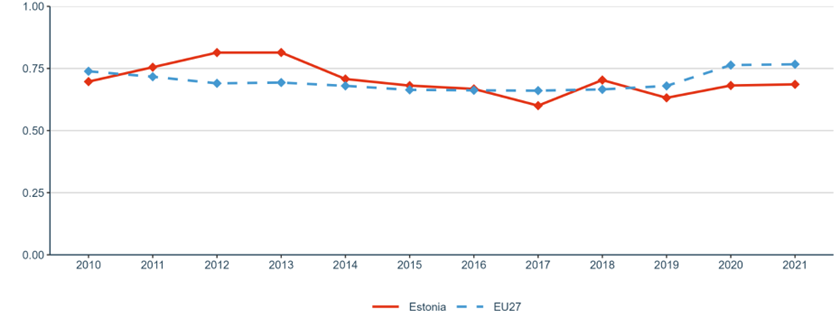
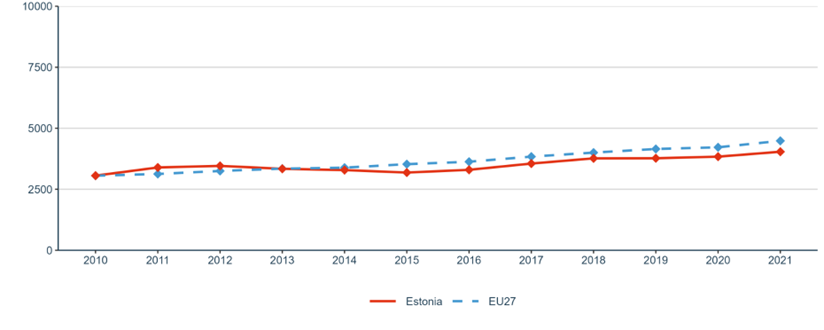

Priority 1: Deepening a truly functioning internal market for knowledge.
Sub-priority 1.1: Open Science

Sub-priority 1.2: Research infrastructures

Sub-priority 1.3: Gender equality, equal opportunities for all and inclusiveness
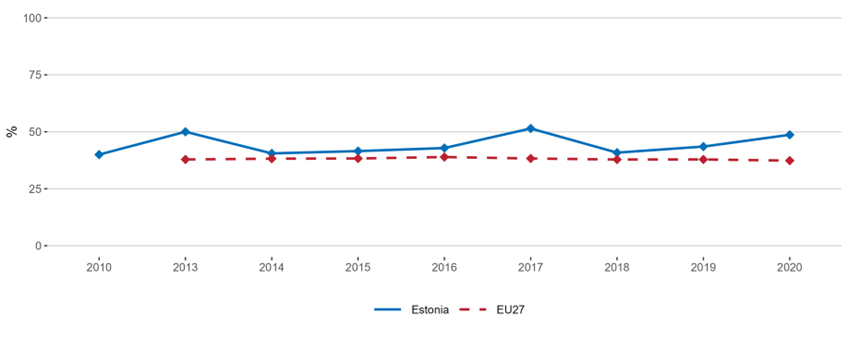

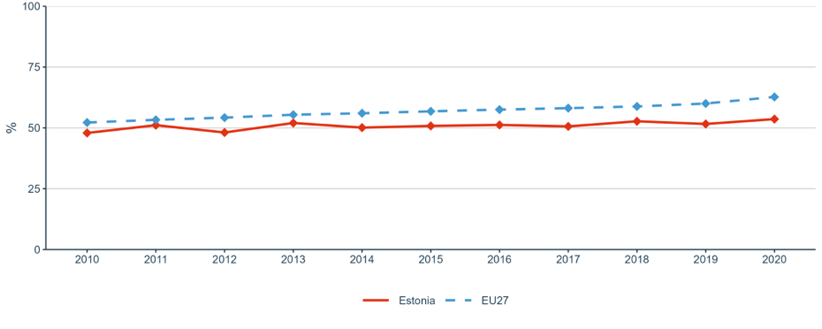

Sub-priority 1.4: Researchers’ careers and mobility and research assessment and reward systems



Sub-priority 1.5: Knowledge valorisation


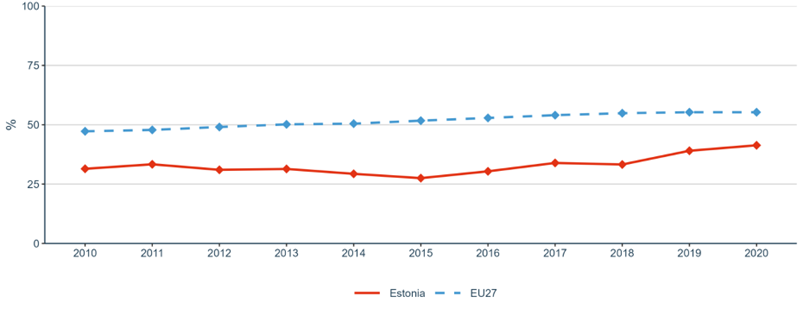
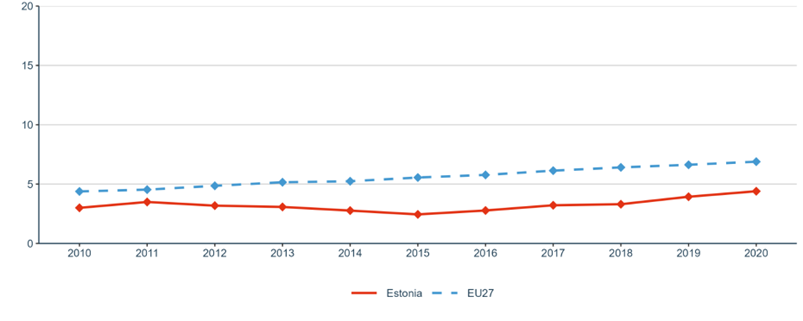
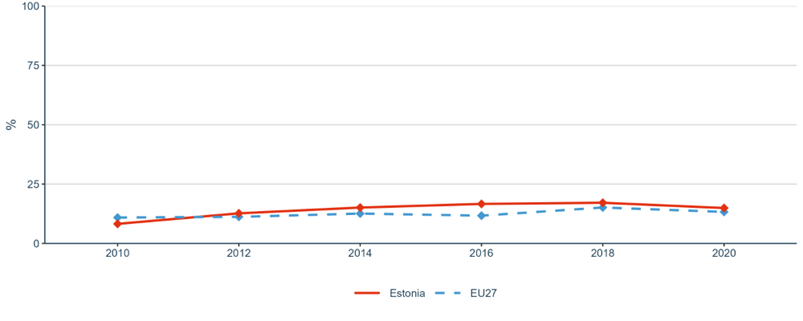
Sub-priority 1.6: Scientific leadership

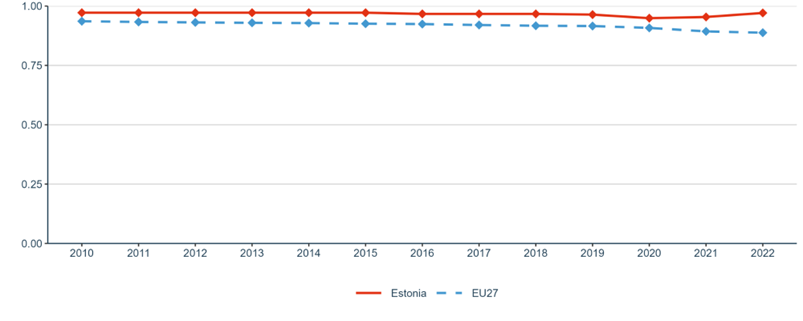
Sub-priority 1.7: Global engagement
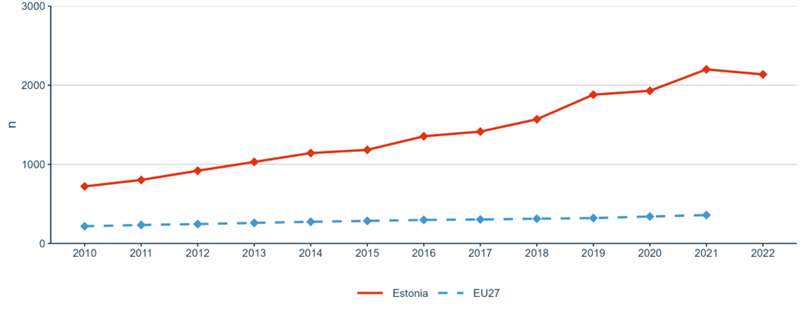
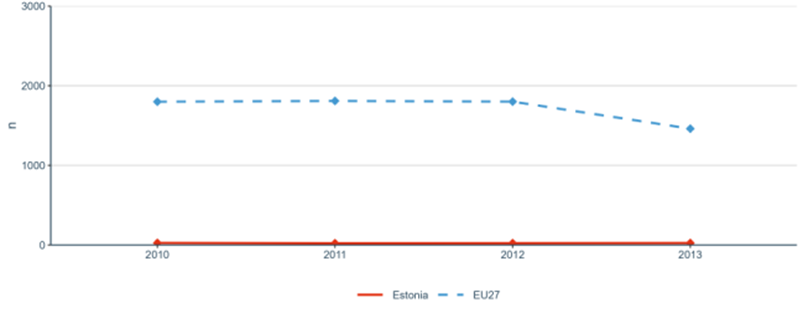
Priority 2: Taking up together the challenges posed by the twin green and digital transition, and increasing society’s participation in the ERA
Sub-priority 2.1: Challenge-based ERA actions

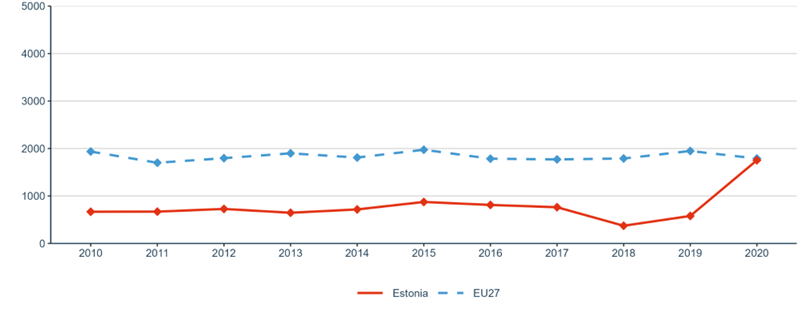
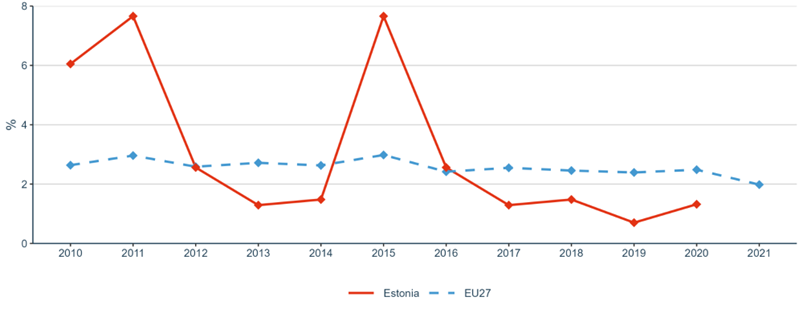
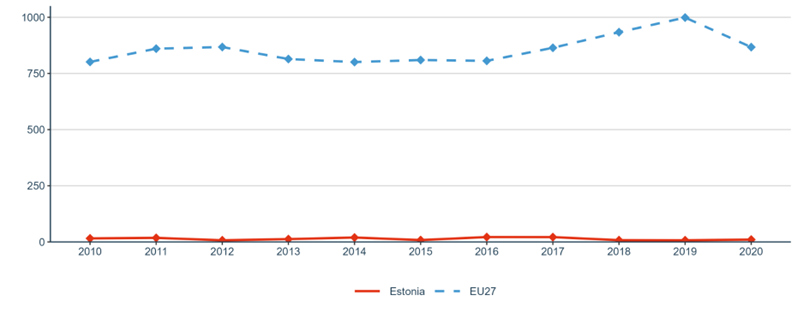
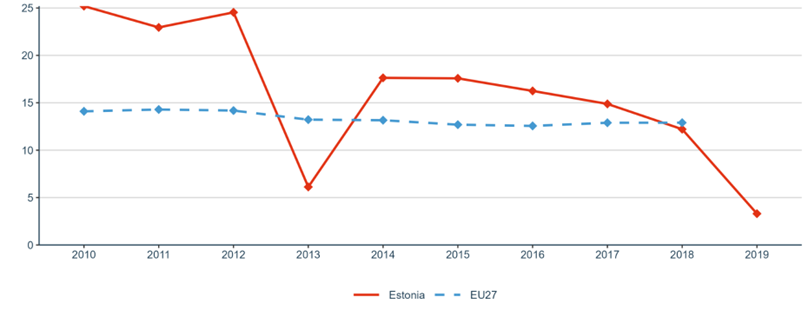
Sub-priority 2.2: Synergies with education and the European Skills Agenda
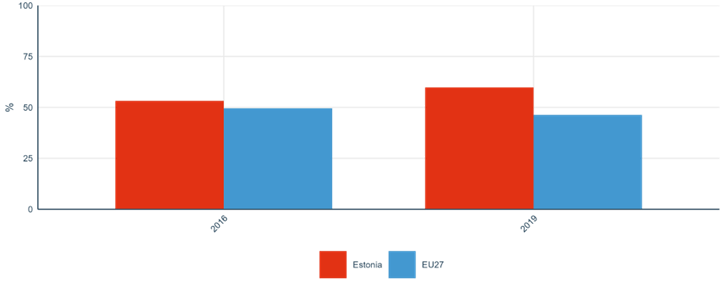
Sub-priority 2.3: Synergies with sectorial policies and industrial policy, in order to boost innovation ecosystems

Sub-priority 2.4: An active citizen and societal engagement in R&I in all its dimensions

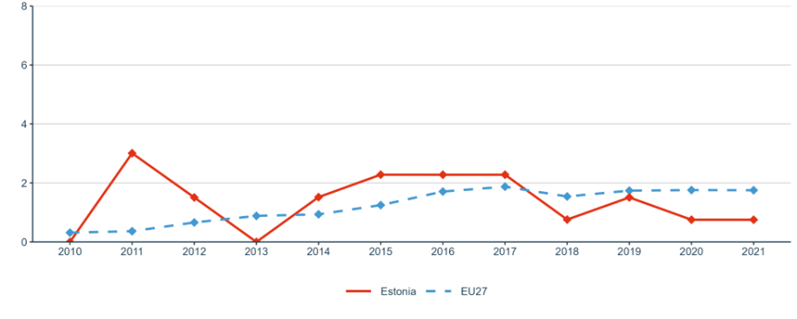
Priority 3: Amplifying access to research and innovation excellence across the Union
Sub-priority 3.1: More investments and reforms in countries and regions with lower R&I performance

Priority 4: Advancing concerted research and innovation investments and reforms
Sub-priority 4.1: Coordination of R&I investments

